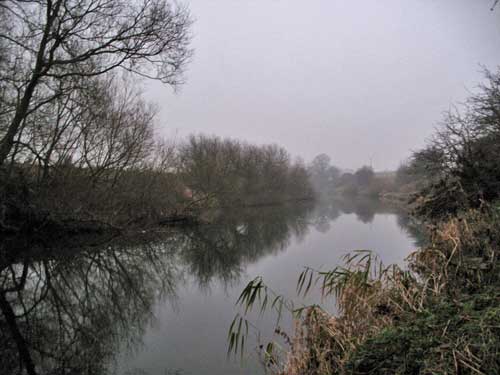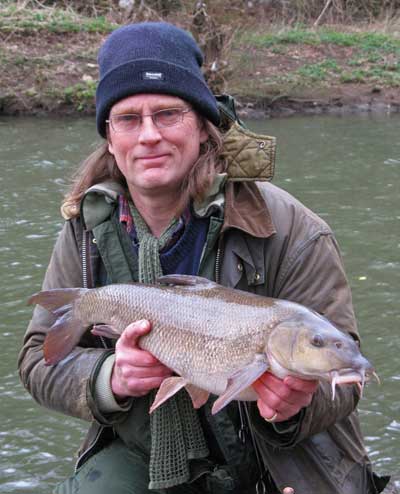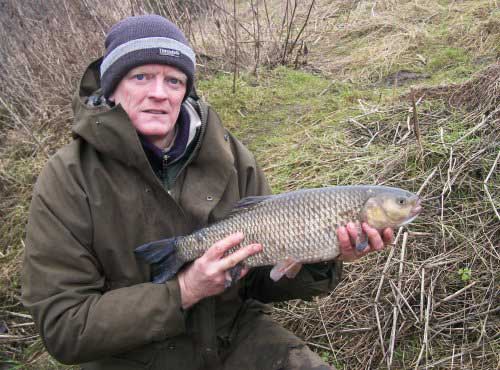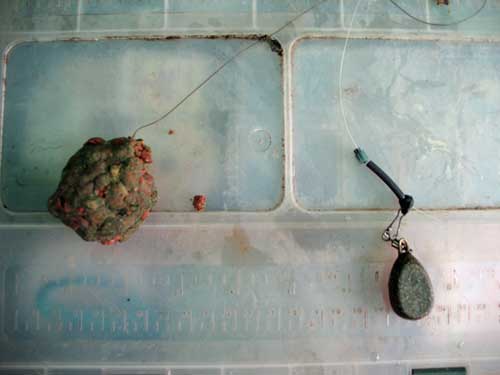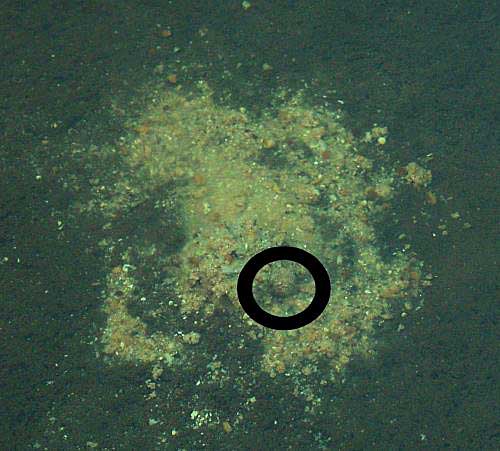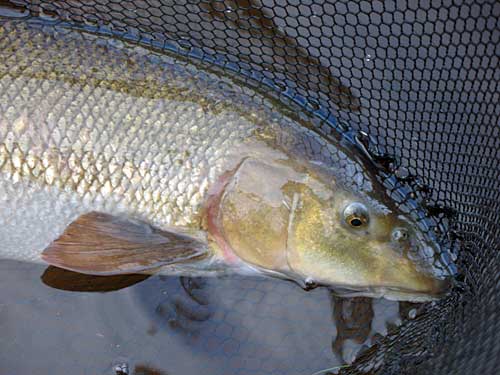| Northern Barbel lead a hard life. Not for them a life of luxury in limpid, chalk-fed streams with luxuriant weeds and shining gravel. No, oop north they live in cold, acid, peat stained spate rivers, with big boulders.
I’m beginning to think that much of what has come to be accepted as fact about barbel behaviour might be true down south, but often doesn’t apply in northern rivers.
Take cold water for example. Winter barbel only feed in warm floods when the rivers are brown and bank high, so in frosty weather barbel fishers stay tucked up in bed where it’s nice and cosy. Hmm….. Remember the cold spell just after Christmas? The temperature barely climbed above freezing for days on end. Well a friend of mine was chub fishing on a cold, clear Swale. He finished up with seven chub and five barbel, losing another two barbel. The bites were all 3ft twitches too. The following weekend I arrived on the Swale for a spot of chub fishing just as the only other angler on the stretch was returning a barbel that weighed 12 1/2 lb, including his landing net. The water temperature was 4.6 C. My mate Mick Beecroft and I have talked about this behaviour a lot over the past few years and we’ve come to the conclusion that maybe the longer daylight hours also have an effect on the barbels’ feeding behaviour. This year I decided to put this theory to the test and see if I could catch barbel consistently in cold water. I wasn’t expecting a lot of action so I modified my chub fishing tactics to keep me occupied. I call it churbelling.
Normally my chub fishing is a mobile affair and I keep moving until I find the fish. Churbelling is static – I’m hedging my bets and fishing in areas where I expect to catch a barbel, but still have a reasonable chance of a good chub. Cold water barbel aren’t mobile and you’ll only find them in certain areas, so I only fish for them in stretches that I know well. What I do is fish for chub with a maggot feeder at the head of a swim and put a barbel rod out at the bottom of the swim. The chub set up is conventional, with double maggot fished on a size 16 hook. The barbel set up is the ‘lumpy paste’ rig that I’ve described in earlier articles. It’s basically a variation on the method feeder, but instead of squeezing the method mix round a feeder I use a bomb and squeeze the method mix round the hookbait. This has the advantage of presenting the hook bait in a small pile of pellets, with no method feeder around to spook wary fish. Mick Beecroft and I have developed this technique over the past few years, but I’ve seen other people doing it too and it’s been reported as a carp match tactic and called the conker. Let me take you through last Saturday’s session to show you what I do. I’ve been ringing Rivercall since Thursday and the Swale has been falling steadily: two metres up on Thursday, one metre up on Friday, 0.5 metres on Saturday morning. Unfortunately it’s been cold and it’s forecast to get colder on Saturday, so I almost leave my barbel rod at home, but I decide to stick to my guns and give it a go. There’s a car in the car park when I arrive so I’m on tenterhooks in case my preferred swim has been taken. I’m rapidly losing confidence as a walk towards my chosen swim as it’s bitingly cold with a brisk south easterly wind. The river has a fair bit of colour in it and doesn’t look to have dropped much since the Rivercall level was taken at 3.00 am. Luckily the other guy has gone further upstream so I drop gratefully into my first choice swim. I feed a few 6mm pellets and set my chub rod up. I’m using a maggot feeder with a 6lb Grand Match hook length and a size 16 hook. I drop the feeder into a deeper scour about half way across the river opposite a far bank bush. The river is pulling through too much to fish the far bank effectively and anyway the chub run big here and I don’t want to lose fish under the bush.
I give Mick a call to see if he’s fishing and we discuss whether it’s worth putting my barbel rod up. The water temperature is 3.8 C so I’m not particularly confident. An hour goes by with no action and I decide that I might as well do something more than watch a stationary rod tip, so I put a few pellets into a bait box, cover them with water and leave them to soak whilst I set up my barbel rod. After five minutes I partially drain the pellets and add some dark method mix until I get a good firm paste laced with soggy pellets. I band a 14mm pellet onto the hook and squeeze a hen’s egg-sized lump of the paste round it. I swing this out so that it lands on the same line as I’m fishing the maggot feeder, but about five yards downstream.
This is the essence of churbelling. The pellets that I fed when I arrive are there to attract fish into the swim without feeding them too much. I’m then fishing a maggot feeder which trickles maggots into the swim keeping the chub occupied and hopefully getting a barbel picking about. The pellet wrapped in paste is there to tempt a barbel that is hanging back from the main feed. I’ll only recast this if too much rubbish builds up on the line, if it’s out for more than a couple of hours, or if I get a fish. If I get indications on the pellet, but no definite bites I’ll switch to maggot. My chub gear is strong enough to give me a good chance of landing a barbel, but more often than not I get the barbel on the downstream rod and the chub on the upstream rod.
I huddle back into my chair, but before long I get a good bite on my chub rod which I miss due to drifting off into a semi-doze. I recast and half an hour later I get another good bite which I hit. Strangely, it’s a grayling rather than a chub – a rare sight in this part of the Swale. Another hour goes by and I’m in the process of recasting my feeder when the tip of the barbel rod whacks round and the baitrunner starts to give line slowly. I hurriedly drop the chub rod and lift into the fish only to feel a slight plink on the line before it goes slack. Cursing I retrieve the line to find that it has gone above the lead (free running) and looks to have been cut by a sharp object. Muttering to myself I set up again and recast. The last few hours are miserable as the wind gets up and it gets even colder, but I’m determined to stick it out until dark as there’s a good chance of a chub and they grow big in this stretch. I’ve given up on the idea of a barbel, but I leave the rod out anyway. As the dusk draws in I reach into my rucksack for my head torch only to find that it isn’t there. This is a disaster as the way back to the car is treacherous in the dark, with hidden rabbit holes threatening a broken leg or a plunge into the icy river. I reach for my chub rod and start to break it down when the screech from the baitrunner on my other rod causes a hurried change of plan. I lift into what is obviously a barbel and after a dour struggle I net a fish of about 7lb. I hurriedly unhook it and continue packing up. As I walk back to the car I mull over a session which looked to be heading for disaster only to be saved by that last minute fish. Summary
I’m sure that this cold water feeding is relatively common, but this last session was a real eye opener. With a bit of luck I’d have had two barbel, caught by design in awful conditions with a water temperature of only 3.8 C. So why don’t you give churbelling a go? After all, carpbelling is soooo last year! |
Welcome!Log into your account










